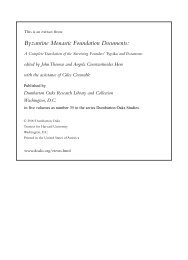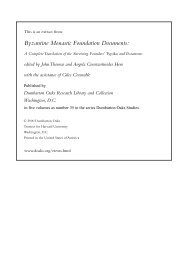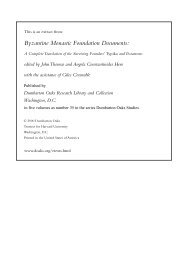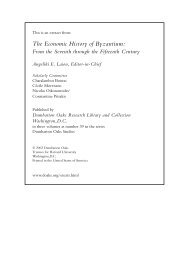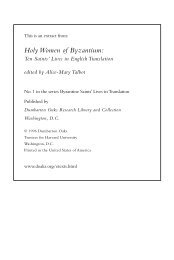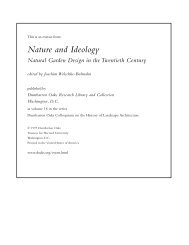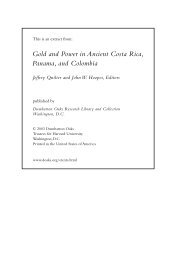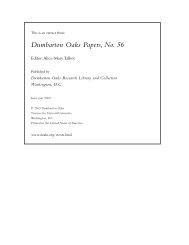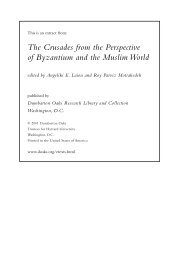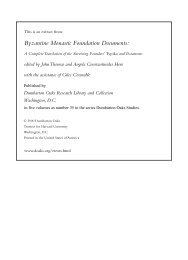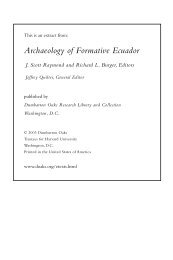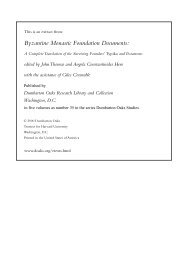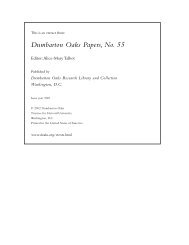22. Evergetis - Dumbarton Oaks
22. Evergetis - Dumbarton Oaks
22. Evergetis - Dumbarton Oaks
You also want an ePaper? Increase the reach of your titles
YUMPU automatically turns print PDFs into web optimized ePapers that Google loves.
ELEVENTH CENTURY<br />
authors of (29) Kosmosoteira and (30) Phoberos borrow from the Evergetian founder’s typikon<br />
directly, the former with attribution and the latter without, in a recension with different chapter<br />
numbers but the same order as found in the model typikon. Probably through one or two intermediaries,<br />
(27) Kecharitomene likewise borrows a substantial amount of Evergetian institutions and<br />
usages as well. Towards mid-century, even documents like (28) Pantokrator and (31) Areia that<br />
are not themselves linked textually to the Evergetian founder’s typikon nevertheless incorporate<br />
Evergetian customs. Later still, (32) Mamas and (33) Heliou Bomon display the unmistakable<br />
impact of another generation’s recension of the Evergetian customary tradition.<br />
The direct historical record is more meager. <strong>Evergetis</strong> was not among those monasteries specifically<br />
recorded as being represented by their superiors at the synod of Blachernai in 1094 that<br />
rehabilitated Leo of Chalcedon, that important turning point in the history of the reform movement.<br />
After this reconciliation of the Komnenian dynasty with the reformers, it was not at all<br />
inappropriate for Alexios Komnenos’ brother-in-law John Doukas to enter <strong>Evergetis</strong> as the monk<br />
Antony, as is recorded in the Appendix to the founder’s typikon, either at the very end of the<br />
eleventh or at the beginning of the twelfth century. In the final form that it has come down to us,<br />
the founder’s typikon cannot be any earlier than this time. Pargoire (“Évergétis,” p. 159) not implausibly<br />
suggested that the existing manuscript of this document and its companion liturgical<br />
typikon, which he believed dated from the mid-twelfth century, is the original copy of the revised<br />
edition.<br />
In 1153, at perhaps the height of the monastic reform movement, an eremitic Evergetian<br />
monk was elected patriarch of Constantinople as Neophytos I (1153). 13 His election was bitterly<br />
opposed, however, and his opponents succeeded in persuading him to give up his office even<br />
before his consecration by recalling his temporary abandonment of his appointment as an ecclesiastical<br />
lector many years before. Around 1180, a delegation of Evergetian monks appeared before<br />
Patriarch Theodosios Boradiotes (1178–83) to resolve how they could obey the command in (22)<br />
<strong>Evergetis</strong> [15] that they should make their confessions exclusively to their superior if, as happened<br />
at the time to be the case, their spiritual director was not ordained. 14<br />
Towards the end of the twelfth century, <strong>Evergetis</strong> began a long, fruitful association with St.<br />
Sava (Sabbas) the Serbian, author of (44) Karyes. 15 This relationship began with Sava’s second<br />
visit to Constantinople during the reign of Alexios III Angelos (1195–1203). According to his<br />
biographer Domitien, Sava visited the monastery at this time, where a pious woman predicted that<br />
he would be gaining two treasures to assist him in his work. Sometime after Sava’s return to his<br />
own monastery of Hilandar on Mount Athos, the bequests materialized upon the death of his<br />
father, the Serbian king Stephen (c. 1166–1196), and he shared a part with <strong>Evergetis</strong>.<br />
E. <strong>Evergetis</strong> under Latin Rule<br />
Unlike the Stoudios monastery and many other less fortunate foundations, <strong>Evergetis</strong> evidently<br />
remained in existence during the Latin occupation of Constantinople (1204–61). 16 In 1206 the<br />
Cardinal-legate Benedict of Santa Susanna granted <strong>Evergetis</strong> along with its properties and dependencies<br />
to Stephen, abbot of the famous Benedictine monastery of Monte Cassino, on the condition<br />
that the Greek monks resident there not be expelled. 17 The document locates the monastery<br />
two miles beyond the walls of Constantinople. Later, Pope Honorius III (1212–27) confirmed and<br />
[ 456 ]




